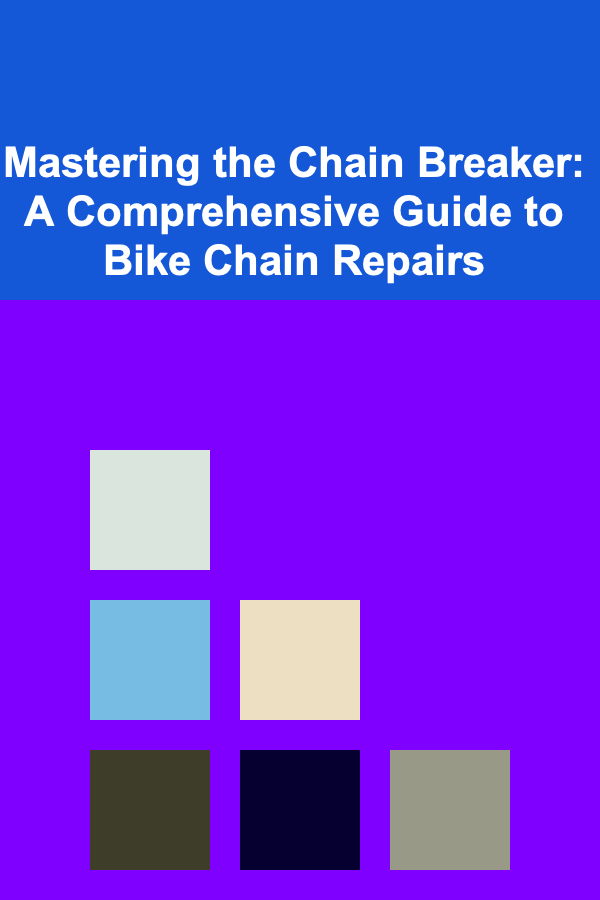
Mastering the Chain Breaker: A Comprehensive Guide to Bike Chain Repairs
ebook include PDF & Audio bundle (Micro Guide)
$12.99$8.99
Limited Time Offer! Order within the next:

A well-maintained bicycle chain is the unsung hero of a smooth and efficient ride. However, even the best chains are susceptible to wear and tear, damage, or simply needing adjustment for optimal performance. The chain breaker, also known as a chain tool or chain splitter, is an indispensable tool for any cyclist who wants to perform basic chain maintenance, repair a broken chain on the road, or replace a worn-out chain altogether. This comprehensive guide will delve into the intricacies of using a chain breaker, covering everything from identifying the right tool to executing various chain repairs with confidence.
Understanding the Chain Breaker
Before diving into the practical aspects of using a chain breaker, it's crucial to understand its anatomy and how it interacts with a bicycle chain. At its core, a chain breaker is a simple device designed to push a hardened pin through the pins that hold the chain links together, effectively separating the chain at a chosen point. Let's break down the key components:
- Body: The main structure of the tool, providing leverage and stability. Chain breakers come in various shapes and sizes, from compact multi-tools for on-the-go repairs to more robust workshop models.
- Pin Pusher: A small, hardened steel pin that extends from the tool's body and is designed to align with and push through the chain pin. The quality of this pin is crucial for the tool's durability and effectiveness.
- Adjustable Platform/Anvil: A platform or anvil that holds the chain in place, ensuring the pin pusher aligns correctly with the chain pin. The anvil often has multiple slots to accommodate different chain widths (single-speed, 6-speed, 9-speed, 11-speed, etc.). Some higher-end tools may even have a floating anvil that moves slightly with the pin pusher, minimizing stress on the chain.
- Handle/Lever: The mechanism used to drive the pin pusher. This can be a simple lever, a screw-type mechanism, or a combination of both. The handle provides the force needed to push the pin through the chain.
Types of Chain Breakers
Chain breakers are not created equal. They vary in quality, features, and intended use. Here's a brief overview of the common types:
- Multi-Tools with Chain Breakers: These compact tools are ideal for carrying on rides for emergency repairs. While convenient, they often lack the precision and durability of dedicated chain breakers. The pin pusher can be more prone to bending or breaking, especially when working with heavily corroded chains.
- Workshop Chain Breakers: These are more robust and precise, designed for frequent use in a workshop setting. They typically have a larger handle for better leverage, a more durable pin pusher, and a more stable platform for holding the chain.
- High-End Chain Breakers: These are the premium options, often featuring advanced features like floating anvils, replaceable pin pushers, and ergonomic designs for comfortable and efficient operation. They are built to last and provide the highest level of precision.
Preparing for Chain Repair
Before you start wielding the chain breaker, proper preparation is key to a successful and safe repair. Here's what you need to do:
Gather Your Tools and Supplies
Besides the chain breaker itself, you'll need the following:
- New Chain (if replacing the chain): Ensure you have the correct chain for your drivetrain. Check your bike's specifications or consult with a bike shop to determine the correct chain type (number of speeds, chain length).
- Master Link (if applicable): Many modern chains use a master link (also called a quick link) for easy installation and removal. If your chain uses a master link, make sure you have a spare on hand.
- Chain Wear Indicator Tool (optional, but highly recommended): A chain wear indicator tool accurately measures chain stretch. Replacing a chain before it becomes excessively worn prevents premature wear of the cassette and chainrings.
- Pliers or Chain Link Pliers (optional): Chain link pliers are specifically designed for opening and closing master links, making the process much easier. Regular pliers can be used, but require more finesse.
- Gloves: Bicycle chains are often greasy and dirty. Gloves will protect your hands.
- Rag: For wiping away excess grease and grime.
- Workstand (optional but recommended): A workstand makes it much easier to work on your bike.
- Chain Lube: Essential for lubricating the new or repaired chain.
Assess the Chain
Before breaking the chain, take a moment to assess its condition. Is the chain broken, worn, or simply too long? Use a chain wear indicator tool to check for excessive chain stretch. If the tool indicates significant wear, it's time for a chain replacement. Look for any signs of damaged links, rust, or stiffness. These issues can contribute to poor shifting and increased wear on other drivetrain components.
Determine the Breaking Point
If you are removing a damaged section of the chain or shortening it, carefully select the link where you will break the chain. Aim for a link that is easily accessible and free from excessive dirt or rust. If you are replacing the entire chain, breaking the old chain at any point will suffice.
Using the Chain Breaker: Step-by-Step Guide
Now, let's get to the heart of the matter: using the chain breaker. Follow these steps carefully to ensure a smooth and successful chain repair.
-
Position the Chain in the Chain Breaker:
Open the chain breaker and place the chain link you want to break into the tool's platform (anvil). Most chain breakers have multiple slots to accommodate different chain widths. Make sure the chain pin is aligned directly with the pin pusher. It is crucial to ensure the chain sits flush against the back of the tool; if it is angled even slightly, you risk bending the tool's pin or damaging the chain plate.
-
Adjust the Chain Breaker:
Adjust the tool's tension so that the pin pusher is just touching the chain pin. Some tools have a knob or screw that adjusts the position of the chain relative to the pin pusher. The goal is to have the pin pusher perfectly aligned with the chain pin before applying any significant force.
-
Drive the Pin Pusher:
Slowly and steadily turn the handle or lever of the chain breaker. You will feel resistance as the pin pusher starts to push the chain pin through the link. Be careful not to apply excessive force, especially with cheaper chain breakers, as this can bend or break the pin pusher. The key is to apply even pressure and gradually push the pin out.
-
Push the Pin Partially Out:
The goal is not to completely remove the chain pin. Instead, push the pin just far enough that the link is separated, but the pin remains partially inserted in the outer plate of the chain. Pushing the pin out completely can make it very difficult to reassemble the chain, especially if you are reusing the same pin. If the pin comes all the way out, don't panic (we'll cover how to deal with this later).
-
Separate the Chain:
Once the pin is partially pushed out, you should be able to easily separate the chain at the broken link. If the link is still stiff, try gently wiggling the chain back and forth to loosen it.
Common Chain Repair Scenarios
Now that you know how to break a chain, let's explore some common scenarios where a chain breaker comes in handy.
Replacing a Broken Chain Link
If a chain link is damaged but the rest of the chain is in good condition, you can replace the damaged link with a new one. This is a temporary solution, but it can get you home in a pinch. Here's how:
-
Remove the Damaged Link: Use the chain breaker to remove the damaged link as described above.
-
Install a New Link:
Using a Master Link: Open the master link (using chain link pliers if available). Attach one half of the master link to each end of the chain. Press the two halves of the master link together. You may need to rotate the pedals slightly to fully engage the master link. Some master links require a specific tool to open and close them safely. Refer to the manufacturer's instructions.
Using a Connecting Pin (Shimano Chains): Shimano chains often use special connecting pins. These pins have a guide that breaks off after installation. Insert the connecting pin through the outer plates of the chain ends. Use the chain breaker to press the pin fully into place. Carefully break off the guide section of the pin. Ensure the link moves freely.
Using a Standard Chain Pin (Not Recommended): If you completely removed the original chain pin, you can try to reuse it, but this is generally not recommended. It can weaken the chain and make it more prone to failure. If you must reuse the pin, carefully align the chain and use the chain breaker to slowly and evenly press the pin back into place. Ensure the pin protrudes equally on both sides and that the link moves freely.
-
Lubricate the Link: Apply a drop of chain lube to the new link to ensure smooth operation.
Shortening a Chain
Sometimes, a new chain might be too long, or you might need to shorten a chain after removing a damaged section. Here's how to shorten a chain:
-
Determine the Correct Chain Length:
There are a few methods to determine the correct chain length:
The "Big-Big" Method: Shift the chain onto the largest chainring in the front and the largest cog in the rear. Without threading the chain through the rear derailleur, overlap the chain ends. Add two links (one inner link and one outer link) to this length. This accounts for the rear derailleur's take-up capacity.
The Derailleur Cage Method: Shift the chain onto the smallest chainring in the front and the smallest cog in the rear. The rear derailleur cage should be roughly parallel to the ground. If the cage is excessively extended, the chain is too short. If the cage is slack, the chain is too long.
-
Break the Chain at the Appropriate Length: Use the chain breaker to remove the excess links. Remember to break the chain so that you have an inner link and an outer link to connect to each other.
-
Connect the Chain:
Using a Master Link: Connect the chain ends using a master link as described above.
Using a Connecting Pin (Shimano Chains): Connect the chain ends using a Shimano connecting pin as described above.
Replacing an Entire Chain
Replacing a worn-out chain is essential for maintaining optimal drivetrain performance. Here's how to replace an entire chain:
- Remove the Old Chain: Use the chain breaker to break the old chain at any convenient point.
- Determine the Correct Length of the New Chain: Use the old chain as a guide, or use one of the methods described above ("Big-Big" or Derailleur Cage Method) to determine the correct length of the new chain.
- Shorten the New Chain (if necessary): Use the chain breaker to remove any excess links from the new chain.
- Install the New Chain: Thread the new chain through the front and rear derailleurs, ensuring it follows the correct routing.
- Connect the Chain: Connect the chain ends using a master link or a Shimano connecting pin, as appropriate.
- Lubricate the Chain: Apply chain lube to the entire length of the chain.
Troubleshooting Common Issues
Even with the best intentions, things can sometimes go wrong. Here are some common issues you might encounter when using a chain breaker and how to address them:
- Bent Pin Pusher: This is a common problem with cheaper chain breakers. Applying excessive force or misaligning the tool can bend the pin pusher. If this happens, you may need to replace the pin pusher or the entire tool. Prevention is key: ensure the chain is properly aligned and use a smooth, controlled motion when driving the pin pusher.
- Damaged Chain Plate: Misalignment or excessive force can also damage the chain plate, causing it to bend or crack. If this happens, you'll need to replace the damaged link or the entire chain.
- Stiff Link After Repair: Sometimes, after reassembling the chain, a link can be stiff and not move freely. This is often caused by a pin that is not fully seated or a slightly deformed chain plate. Try gently flexing the link back and forth to loosen it. If that doesn't work, use the chain breaker to very slightly push the pin further in or out (only a fraction of a millimeter at a time). Be careful not to overdo it.
- Pin Completely Removed: If you accidentally push the chain pin all the way out, it can be tricky to reassemble the link. The best solution is to use a new connecting pin (if your chain uses them) or a master link. If you must reuse the original pin, carefully align the chain and use the chain breaker to slowly and evenly press the pin back into place. Ensure the pin protrudes equally on both sides and that the link moves freely. This is much easier to accomplish before the chain is mounted on the bike.
- Inability to Break the Chain: This can be due to several factors, including a dull pin pusher, a corroded chain, or insufficient force. Ensure the pin pusher is sharp and properly aligned. Try applying penetrating oil to the chain pin and let it sit for a few minutes before attempting to break the chain again. If the tool is simply not strong enough, consider investing in a higher-quality chain breaker.
Chain Maintenance Best Practices
Regular chain maintenance is crucial for extending the life of your chain and drivetrain. Here are some best practices to follow:
- Regular Cleaning: Clean your chain regularly to remove dirt, grime, and old lubricant. Use a chain cleaning tool or a rag and a degreaser.
- Proper Lubrication: After cleaning, apply chain lube to the entire length of the chain. Wipe away any excess lube to prevent dirt buildup. Choose a lube that is appropriate for your riding conditions (wet, dry, or all-weather).
- Check for Wear: Use a chain wear indicator tool regularly to check for chain stretch. Replace the chain before it becomes excessively worn to prevent premature wear of the cassette and chainrings.
- Inspect for Damage: Regularly inspect your chain for damaged links, rust, or stiffness. Address any issues promptly.
- Proper Shifting: Avoid shifting under heavy load, as this can damage the chain and other drivetrain components.
Conclusion
The chain breaker is an essential tool for any cyclist who wants to perform basic chain maintenance and repairs. By understanding the tool's anatomy, following the steps outlined in this guide, and practicing proper chain maintenance, you can keep your bicycle chain in top condition and enjoy a smooth and efficient ride for years to come. While mastering the chain breaker takes practice, the ability to repair your chain on the road or at home can save you time, money, and a lot of frustration. So, invest in a quality chain breaker, practice using it, and become confident in your ability to tackle any chain-related issue that comes your way. Happy cycling!

Can Deep Learning Be a Source of Passive Income? Here's How
Read More
How to Combine SMS with Email for a Multi-Channel Abandoned Cart Recovery Strategy in Dropshipping
Read More
How to Reduce Footstep Noise with Soundproofing Techniques
Read More
How to Save for Retirement While Managing Daily Expenses
Read More
Unlocking Game Development Secrets: Techniques and Technologies for the Next Generation of Game Masters
Read More
How to Model Low-Poly Assets for Mobile Games
Read MoreOther Products

Can Deep Learning Be a Source of Passive Income? Here's How
Read More
How to Combine SMS with Email for a Multi-Channel Abandoned Cart Recovery Strategy in Dropshipping
Read More
How to Reduce Footstep Noise with Soundproofing Techniques
Read More
How to Save for Retirement While Managing Daily Expenses
Read More
Unlocking Game Development Secrets: Techniques and Technologies for the Next Generation of Game Masters
Read More